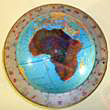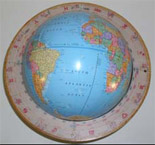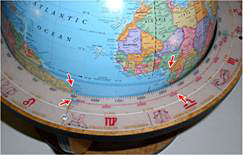|
An Ockham Razor Expanding Globe Experiment By Keith Wilson One of the simplifiers of understanding complicated science is Ockham’s Razor (Occam’s Razor) which generally states, “All things being equal, the simplest solution tends to be the best one.” We will see if a simplified solution for the movement apart of continents can be shown with an expanding earth globe demonstration. This experiment can be conducted at home with a standard 12″ Globe, an Expanding Earth Knowledge 12” Globe stand, and a Hoberman sphere that expands from a 6″ to 12″ diameter. A variety of types of paper, plastic or metal mesh can be used to cut out the continents. As shown below, the Hoberman sphere mechanically expands from 6″ to 12″ in diameter. This is placed into the globe stand to show the Hoberman does accurately expand to represent a 12” globe size.
Plate Tectonics (PT) states that the continents moved apart on a constant size earth by moving apart horizontally on the surface. Expanding Earth (EE) theory says the Earth has expanded from about 50% of its current diameter, and that the continents fit together with no oceans, just shallow seas. EE says that primarily the continents kept their positions relative to the core, but that expansion pushed them further away from the core. In so doing the continents then moved apart. These movements were really vertical from the core, but on the Earth’s surface the movement looks horizontal. This size Hoberman sphere accurately portrays this motion.
You may notice that in the Bullard Fit, Africa was made smaller and appears to be the same size as South America, when it’s actually 70% larger. For accuracy, we use the actual size.
This is an experiment that can be done at home that shows evidence that the Earth Continents could have moved to their present location just by expanding the diameter of the sphere. That the earth continentscould have moved vertically away from the core and give the visual appearance of moving horizontally apart. This experiment shows what has been taught by Earth Expansion Theory for over 50 years. This experiment can be done mechanically for an Expanding Earth model but it cannot be done mechanically for a Plate Tectonic model. Which would Ockham’s Razor state was a simpler solution? Unexpected Findings from the Experiment This experiment was done to show how expansion alone changes continental shapes. The experiment developed 2 unexpected findings. Sam Carey’s work indicated that expansion was not symmetrical but was asymettrical. That 70% of the Expansion occurred in the Southern Hemisphere. The experiment showed a very symmetrical expansion however. 1) What this implies for future small earth continental fit reconstructions is that expansion appears to be symmetrical in LONGITUDE displacement and asymmetrical in LATITUDE displacement. 2) Another important observation occurred. This partially addresses the differences small earth modelers have had in placing Indian and Pacific Ocean landmasses. If continents can be placed on a small model and hold their positions accurately on an enlarged model, then the reverse will likely be true. A continent can be placed on a enlarged model and its original location can be more accurately determined byreducing the Hoberman model size.
|
An Ockham Razor Expanding Globe Experiment
About admin
Subscribe
Related Posts:
- Our Expanding Earth Article (Book Review)
- Linking Mayan Prophesy with Pole Shifts and Expanding Earth Evidence.
- Earth Expansion Causal Evidence Continental Shape Shift and the Solstice Correlation
- Comparing Past Small Earth Reconstructions, and a new approach utilizing Planet Impact Evidence, Submerged Sediment Areas, and the Re-Shaping of Continents.
- The True Lunar Orbit, New Mars Size Impact Evidence, and Earth Expansion Implications















Comments are closed.